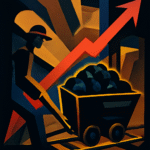Key Points
- The CATL’s Jianxiawo lithium mine shutdown in Yichun, China, is primarily due to an expired permit, though it highlights deeper regulatory issues regarding mine classification.
- Mines like Jianxiawo (with a 0.27% lithium ore grade) are registered as ceramic clay mines, not true lithium mines (which require ≥0.4% lithium oxide grade), creating an “identity crisis” under new regulations.
- The Jianxiawo mine processed an estimated 10,000 tons of lithium carbonate per month, accounting for about 1/8th of China’s total monthly output, and its shutdown has significantly impacted the global market.
- Local villagers tracking lithium prices believe mining becomes profitable above ¥100,000 RMB ($13,800 USD) per ton, and CATL would restart operations if prices hit ¥200,000 RMB ($27,600 USD).
- A new New Mining Law (Xin Kuangye Fa 新矿业法), effective July 1, 2025, requires mines to formally prove lithium as their primary economic driver, potentially preventing easy re-permitting for lower-grade lithium-bearing sites.

The CATL’s Jianxiawo lithium mine shutdown is sending shockwaves through the EV battery world, and the story on the ground is even wilder.
In Yichun, China—a city with dreams of becoming the “Asian Lithium Capital“—the abrupt halt of a key mine has everyone from local villagers to global investors on edge.
This isn’t just about one expired permit.
It’s a look inside the complicated, high-stakes game of securing the raw materials that power our electric future.
Let’s break down what’s happening and why it matters.
The Situation on the Ground: Tight Security and Villagers-Turned-Analysts
Getting information about the mine isn’t easy.
Reporters visiting the Jianxiawo mine, operated by battery giant Contemporary Amperex Technology Co. Limited (CATL) (Ningde Shidai 宁德时代), were stopped by security guards miles away.
But in the nearby villages, the locals have become surprisingly savvy market analysts.
“You’re the third group this month to ask about the mine,” one villager told a reporter.
They’ve seen this before.
The mine, which officially halted operations on August 9 due to an expired permit, has a history of starting and stopping based on market conditions.
Local workers, who are often on short-term contracts of three to six months, recalled a previous shutdown that lasted five months—from late September 2023 to February 2024.
Why? The price of lithium carbonate had tanked to around ¥50,000 RMB ($6,900 USD) per ton, making it unprofitable to keep digging.
Today, these villagers are glued to their phones, tracking lithium prices like day traders.
- They know the local mine run by Gotion High-Tech (Guoxuan Gaoke 国轩高科) has a lithium ore grade of 0.27%.
- They know mining only makes sense when lithium carbonate prices are above ¥100,000 RMB ($13,800 USD) per ton.
- One villager confidently stated that if prices hit ¥200,000 RMB ($27,600 USD), CATL would find a way to restart operations, no matter what.

Resume Captain
Your AI Career Toolkit:
- AI Resume Optimization
- Custom Cover Letters
- LinkedIn Profile Boost
- Interview Question Prep
- Salary Negotiation Agent

The Million-Dollar Question: Why Let the Permit Expire?
This is where it gets interesting.
CATL knew its permit was expiring on August 9.
On an earnings call just 10 days earlier, on July 30, a company exec said they had already submitted the renewal paperwork to the Yichun Natural Resources Bureau (Yichun Ziran Ziyuan Ju 宜春市自然资源局).
They even expressed optimism about getting the approval.
Yet, the deadline passed, and the mine shut down.
This unexpected halt points to a much bigger problem: a systemic identity crisis for Yichun’s lepidolite mines.

An Identity Crisis: Is It a Clay Mine or a Lithium Goldmine?
Here’s the bureaucratic catch that’s causing all this chaos.
The Jianxiawo mine, and many others in the area, aren’t officially “lithium mines.”
They are registered as ceramic clay (taoci tu 陶瓷土) or tantalum-niobium (tannibi 钽铌) mines that just happen to contain lithium.
The distinction is critical:
- True Lithium Mines: These require a lithium oxide (yanghualiyao 氧化锂) grade of ≥0.4%. They are managed by China’s national Ministry of Natural Resources (Ziran Ziyuan Bu 自然资源部).
- Lithium-Bearing Mines: These, like Jianxiawo with its 0.27% grade, fall under local authorities. The approval process is much more lenient.
When lithium carbonate prices skyrocketed from ¥50,000 RMB ($6,900 USD) to nearly ¥600,000 RMB ($82,800 USD) between 2021 and 2022, these “clay mines” became de-facto lithium mines.
The lithium was suddenly far more valuable than the clay.
This gold rush attracted major players like CATL, Gotion High-Tech (Guoxuan Gaoke 国轩高科), Ganfeng Lithium (Ganfeng Liye 赣锋锂业), and Corun (Keli Yuan 科力遠), all setting up shop in Yichun.
CATL’s Chairman, Zeng Yuqun (Zeng Yuqun 曾毓群), even said if prices stayed high, “we will extract as much as we can.“
But now, the regulators are cracking down, and this “identity crisis” is forcing a tough question: can a mine legally be one thing but economically another?

Find Top Talent on China's Leading Networks
- Post Across China's Job Sites from $299 / role, or
- Hire Our Recruiting Pros from $799 / role
- Qualified Candidate Bundles
- Lower Hiring Costs by 80%+
- Expert Team Since 2014
Your First Job Post

The Ripple Effect: One Mine Shakes the Global Market
The Jianxiawo mine is a beast.
Its refinery network churns out an estimated 10,000 tons of lithium carbonate per month.
That’s roughly:
- 1/8th of China’s total monthly output.
- 1/10th of China’s total monthly demand.
With the market already tight for the third quarter, this shutdown could create a monthly supply gap of several thousand tons, directly impacting prices.
The market is already reacting. News of the shutdown sent lithium carbonate prices surging.
This shutdown also impacts the three refineries CATL operates in the area, including a joint venture with Longpan Technology (Longpan Keji 龙蟠科技).
A Longpan official admitted their output would be affected, and they’re now scrambling to buy ore from external sources to avoid a full stop.
- Estimated Monthly Lithium Carbonate Output: 10,000 tons
- Share of China’s Total Monthly Output: ~1/8th
- Share of China’s Total Monthly Demand: ~1/10th
- Potential Impact: Creates a monthly supply gap, impacts prices and linked refineries.

ExpatInvest China
Grow Your RMB in China:
- Invest Your RMB Locally
- Buy & Sell Online in CN¥
- No Lock-In Periods
- English Service & Data
- Start with Only ¥1,000

What’s Next? The “Exploration to Mining” Gauntlet
The story doesn’t end with CATL. The local government has put seven other mining companies on notice.
The Yichun Natural Resources Bureau (Yichun Ziran Ziyuan Ju 宜春市自然资源局) issued a notice in July telling these companies they have until September 30 to prepare new reserve verification reports and “scientifically and reasonably determine the main mineral type for extraction.“
This is where the new New Mining Law (Xin Kuangye Fa 新矿ye Fa), effective July 1, 2025, comes into play.
According to experts like Xie Bin (Xie Bin 谢斌), a senior geological engineer, the new law follows a “loose exploration, strict mining” principle.
To change from a “lithium-bearing clay mine” to a “lithium mine,” a company can’t just flip a switch. It’s a formal legal procedure.
The key isn’t whether the ore “contains lithium,” but whether “the value of lithium is sufficient to make it the primary focus.“
To prove this, a company must:
- Invest in supplementary exploration to meet higher standards.
- Prepare a formal resource reserve report proving lithium is the primary economic driver.
- Get the report reviewed and approved by the competent authorities.
This process is the “narrow exit of the management funnel,” designed to prevent speculation.
But here’s the kicker: if the mine’s grade (like Jianxiawo’s 0.27%) doesn’t meet the official industrial grade for a lithium mine (which some experts say is a cutoff of 0.5% or higher), it might never get a new permit as a lithium mine.

The Price Forecast: Bull vs. Bear
So, can the recent surge in lithium prices continue?
The market is caught in a tug-of-war.
The Bull Case: Supply Disruption
- The Jianxiawo shutdown alone could slash this year’s supply by over 40,000 tons.
- If other mines in Yichun face similar issues, the supply shock could be much worse.
- Industry analysts from CITIC Futures (Zhongxin Qihuo 中信期货) say short-term market sentiment is very strong, with significant upward momentum.
The Bear Case: High Inventory & Cheaper Alternatives
- Total lithium carbonate inventory is at a historical high of 142,400 tons (as of August 7).
- Mica-based lithium extraction is expensive, with costs over ¥60,000 RMB ($8,280 USD) per ton.
- Salt lake lithium extraction is much cheaper, with costs as low as ¥30,000 to ¥50,000 RMB ($4,140-$6,900 USD) per ton, acting as a price anchor.
- China’s lithium industry is also actively fighting “involution-style” vicious competition, calling for rational planning of new capacity.
The immediate future hinges on what happens by the September 30 deadline and how long the government reviews take.
As one expert, Zhang Xu (Zhang Xu 张旭), puts it, despite lithium rebounding to ¥80,000 RMB ($11,040 USD), there’s “no definitive conclusion yet” on how this regulatory showdown will end.
For investors, founders, and anyone in the EV space, the CATL’s Jianxiawo lithium mine shutdown is a critical event to watch, highlighting the fragile and complex supply chains that underpin the green revolution.

References
- The Jianxiawo Mining Area in Ningde: Villagers Await Resumption While Watching Lithium Prices; How Will the Former “Lithium Mine” Address Its Identity Crisis? – CaiLianPress
- CATL Official Website – Contemporary Amperex Technology Co. Limited
- Gotion High-Tech Official Website – Gotion High-Tech Co., Ltd.
- Ganfeng Lithium Official Website – Ganfeng Lithium Group Co., Ltd.





